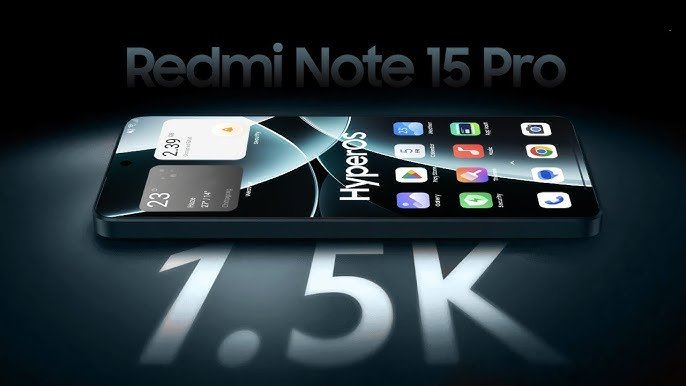Redmi New Phones 2025: Budget Flagships, Specs & Release Updates You Must Know
In 2025, Redmi is expanding its lineup with everything from battery-packed budget phones to near-flagship devices. The Redmi New Phones 2025 lineup includes the global Redmi Note 14 series (debuted in January) and new entries like the Redmi 14C and Redmi 15 models. Leaks also hint at future Redmi releases like a powerful Redmi K90 Pro Max flagship and a “Turbo” series refresh. Xiaomi’s shift to the new HyperOS (replacing MIUI) is another key theme, with Redmi devices running HyperOS 2 or 3 for added performance and connectivity. This guide covers all official Redmi announcements and confirmed specs for 2025, plus the hottest rumors and comparisons – so you know which upcoming Redmi phones to watch.
< Back Next >
Official Redmi Phone Launches 2025
Redmi kicked off 2025 with a flurry of official releases. Key launches so far include:
-
Redmi Note 14 series (Jan 2025) – A global launch featuring five models: Note 14, Note 14 5G, Note 14 Pro, Note 14 Pro 5G, and Note 14 Pro+ 5G. Highlights include up to a 200MP main camera on the Pro+ model, Gorilla Glass Victus 2 on front and back, and IP68 dust/water resistance on higher-end units.
-
Redmi 14C 5G (Jan 2025) – An entry-level 5G smartphone with a 6.88-inch 120Hz display, 5,160mAh battery (18W charging), and Snapdragon 4 Gen 2 chipset. It offers a large screen and long battery life in a budget-friendly package.
-
Redmi Note 14 SE (Jul 2025) – Released in India, essentially a rebranded Note 14 5G for ₹14,999 (~$175). It uses a MediaTek Dimensity 7025-Ultra chip, 6.67″ 120Hz AMOLED screen, 50+8+2MP cameras, and a 5,110mAh battery with 45W charging.
-
Redmi 15 5G (Aug 2025) – A mid-range phone designed for longevity: 7,000mAh battery (silicon-carbon tech), 6.9″ FHD+ 144Hz display, Snapdragon 6s Gen 3 chipset, and 33W charging. It also supports HyperOS 2 and up to 16GB RAM (with RAM expansion).
-
Redmi 15C (Late 2025) – A budget model with a slim 7.99mm design, 6.9″ FHD+ 120Hz screen, 6,000mAh battery (33W charging), MediaTek Helio G81-Ultra processor, and dual rear cameras (50MP main + depth). It runs Xiaomi’s HyperOS 2 out of the box for a smooth software experience.
Each model caters to a different segment. The Redmi Note 14 series targets higher-end buyers with flagship-like specs, while the Redmi 15 family and 14C focus on massive batteries and displays in the midrange/budget tier.
Redmi Note 14 Series (January 2025)
The global Redmi Note 14 series launched in January 2025 with five variants: two base models and three Pro models (each available in 4G or 5G versions). The top model, Redmi Note 14 Pro+ 5G, stands out with a 6.67″ 1.5K AMOLED display (120Hz refresh) and a vegan leather back. It is powered by Snapdragon 7s Gen 3 and packs a 200MP main camera with optical stabilization, plus 8MP ultrawide and 2MP macro lenses. The Pro+ supports extremely fast 120W charging for its 5,110mAh battery. The Note 14 Pro 5G (non-Plus) uses MediaTek’s Dimensity 7300-Ultra chip and has a similar 200MP main camera, a slightly smaller 5,000mAh battery (45W charging), and IP68 protection. The base Note 14 5G model drops to a 50MP camera and 5500mAh battery (45W), but still offers Gorilla Glass 5 and side-mount fingerprint. Even the budget variants include generous RAM (8GB) and storage (256GB) for their price. In short, Redmi has brought flagship-level cameras and fast charging down into the midrange with this series.
Redmi 14C 5G (January 2025)
The Redmi 14C 5G debuted globally as a budget-friendly 5G phone. It features a 6.88″ HD+ (up to 120Hz) IPS display and a 5,160mAh battery with 18W charging. Inside is Qualcomm’s entry-level Snapdragon 4 Gen 2 processor, paired with 4GB RAM and up to 128GB storage (expandable via microSD). For optics, the 14C 5G offers a 50MP main camera and an 8MP ultrawide shooter, plus a 5MP front camera. Xiaomi has positioned this phone for buyers who want a large screen and all-day battery life at a rock-bottom price (around $140). It launched with Android 14/HyperOS 2 and premium software features like memory extension. In short, Redmi is undercutting competitors by giving 5G, a big battery, and a 120Hz display to a very affordable device.
Redmi Note 14 SE (July 2025)
In July 2025, Xiaomi released the Redmi Note 14 SE in India. This phone is essentially a rebadged Redmi Note 14 5G, tweaked for the Indian market. It includes a MediaTek Dimensity 7025-Ultra chipset, 6GB RAM, and 128GB storage. The display is a 6.67″ FHD+ AMOLED panel at 120Hz. Camera hardware is robust: 50MP main (Sony sensor) + 8MP ultrawide + 2MP depth + 20MP selfie. Power comes from a 5,110mAh battery with 45W fast charging. Notably, it launched at just ₹14,999 (~$173 USD) for the 6GB/128GB model, reflecting Redmi’s aggressive value strategy. The Note 14 SE retains features like AI image processing and Gorilla Glass on the front. It undercuts many competitors by offering high refresh rate, large battery, and multiple cameras at a very low price.
Redmi 15 5G (August 2025)
The Redmi 15 5G is a recent release (Aug 2025) aimed at users needing extreme battery life. Its headline spec is a 7000mAh battery – one of the largest in any smartphone this year – using new silicon-carbon battery technology. The phone’s 6.9″ LCD display is FHD+ with a very high 144Hz refresh rate (180Hz touch), making scrolling and games buttery smooth. The chipset is Qualcomm’s Snapdragon 6s Gen 3 (4nm), a midrange 5G SoC. Configurations go up to 12GB RAM + 256GB storage (plus dynamic RAM extension to 16GB). The rear camera array consists of a 50MP main sensor (with a Samsung GM5xx sensor), an 8MP ultrawide, and a 2MP macro lens. Selfie duties go to an 8MP front camera. This device launched with Android 14/HyperOS 2 and a promise of 4 years of updates on the “fresh like new” program. In everyday use, the 15 5G easily lasts two days on a charge, and can even reverse-charge other devices at up to 10W. Redmi markets it as a workhorse phone that “doubles as a power bank” due to its huge battery and efficient chip.
Redmi 15C (Late 2025)
The Redmi 15C is a newly revealed budget model expected by late 2025. It sports a slim 7.99mm aluminum frame and a 6.9″ FHD+ display (120Hz, 270Hz touch). Key specs include a MediaTek Helio G81-Ultra processor, 4/8GB RAM (with memory expansion up to 16GB), and 64/128GB storage (expandable). The rear camera setup is a 50MP main lens plus a 2MP depth sensor, and it uses Samsung’s GN1 sensor. The 15C carries a generous 6000mAh battery (Rubberized silicon-carbon anode) with 33W wired charging. It also offers IP64 dust/splash resistance. On software it runs HyperOS 2 (Android 14) and includes Xiaomi’s ecosystem features like cross-device file transfer. This phone is designed as an all-rounder budget model: large battery, fast screen, a good camera, and a premium OS experience at an estimated sub-$160 price. It shows how Redmi continues to enhance low-end phones with features normally found higher up the lineup.
Rumors and Leaks for 2025
The Redmi 2025 roadmap isn’t limited to official releases. Several upcoming models have leaked or been teased:
Redmi Turbo 5 (Late 2025 / Early 2026)
Redmi’s “Turbo” line (known for battery monsters) appears to be getting a new member. Leaks suggest a Redmi Turbo 5 arriving around late 2025 (global launch maybe as Poco X8 Pro in early 2026). Rumored specs include an enormous 7,500mAh battery with 100W wired charging (a big jump over the 6,550mAh in Turbo 4). It is said to use a 6.5″ 1.5K LTPS display (likely 90Hz or 120Hz) and to have a metal frame with an under-display fingerprint sensor. Sources vary on the chipset: one says MediaTek Dimensity 8500-Ultra, another says Snapdragon 8 Elite Gen 5, so that isn’t confirmed yet. We do know the Turbo 5 will likely ship with Android 15 (HyperOS 3) and MIUI 15 UI. In short, expect the Turbo 5 to be a hardcore all-day phone with monster battery and mid/high-tier performance, similar in spirit to its predecessors.
The Redmi Turbo 5 is expected to continue the series’ tradition: ultra-long battery life, big screens, and value pricing for power users. Its rumored 7500mAh battery and high refresh display could make it the ultimate “battery king” when it launches.
Redmi K90 Series (Late 2025)
Xiaomi has publicly teased the next Redmi K90 flagship series for China around October 2025. The lineup will include at least a K90 Pro Max model. Early details from teasers indicate this could be Redmi’s most powerful phone ever. The K90 Pro Max is said to use Qualcomm’s latest Snapdragon 8 Elite Gen 5 chipset (on 3nm) – one of the first phones with this new chip. Leaks mention a 6,000mAh battery and possibly up to 7,560mAh (if Xiaomi continues its big-battery streak). The K90 Pro Max is expected to feature an advanced camera array, including for the first time in a K-series phone a periscope telephoto lens (reportedly 5x optical zoom and 64MP Tele macro sensors). Audio is also a focus: Xiaomi teased a Bose-tuned stereo speaker setup. Pricing is rumored around CNY 3,999 (~$560) for the Pro Max base model, making it a “flagship killer” strategy. Internationally, the K90 series will be rebranded as POCO X8 (Ultra and Pro models) to hit other markets. In summary, the Redmi K90 series promises true flagship hardware (Snapdragon Elite, periscope zoom) at pricing well below top-tier brands.
Redmi Note 15 Series (2026)
Looking further ahead, a Redmi Note 15 series is expected in early 2026 (likely January). This would follow the Jan-2023 Note 13 and Jan-2024 Note 14 cadence. Early leaks (and Chinese launches of Note 15/15 Pro 5G) suggest the global Redmi Note 15 may include a vanilla 4G version, a 5G Pro model, and possibly a high-end Pro+ variant. Tentative specs from Chinese models point to chips like MediaTek Dimensity 7200-Ultra on the Pro+ (for example), 200MP main cameras again, and batteries around 5000–5200mAh with 67W or 90W charging. If Redmi follows its usual pattern, the Note 15 lineup will continue offering massive displays (likely 6.7″+ AMOLED, 120Hz), multi-camera setups (including wide/ultrawide/macro or tele), and midrange chipsets aimed at beating out competitors on value. Since global Redmi Note 15 details are still unconfirmed, watch for the usual January 2026 launch window.
Other Redmi Rumors
Other rumored Redmi projects include a possible “K70 Extreme Champion Edition” – a high-performance variant of last year’s K70, possibly for China late 2025. There might also be minor updates to budget lines (A-series refresh) or surprise models (like gaming-focused Redmi phones). For now, the main leaks focus on the Turbo series, K-series flagships, and the next Note series. Each rumor reflects Redmi’s strategy: bring “flagship” level features (big batteries, high-end cameras, fast screens) down to affordable price points. Keep an eye on Xiaomi’s official announcements and Weibo teasers, as those will eventually confirm or deny these rumors.
Software: MIUI vs HyperOS
On the software front, 2025 sees Xiaomi fully transitioning from its old MIUI branding to the new HyperOS (Android 16-based) platform. All the new Redmi phones (like 15 5G and 15C) ship with HyperOS 2 or higher, which means the latest system optimizations, AI features, and deep integration with Xiaomi’s ecosystem. HyperOS introduces things like memory extension (using flash storage as extra RAM), AI text editing in the camera app, cross-device collaboration, and more streamlined settings. Redmi buyers will notice a more modern, unified interface across phones, tablets, and PCs that use HyperOS.
Older Redmi devices are also being upgraded to HyperOS. For instance, Xiaomi began rolling out HyperOS 3 (Android 16, One UI 5-level) to existing high-end models like the Redmi K80 and Turbo 4 series in late 2025. The Redmi Note 14 series will receive HyperOS 3 in China (and the global Note 14/Note 14 SE likely soon after). Xiaomi has committed to roughly 3 major Android updates and 4 years of security patches for its Redmi flagships, meaning these 2025 phones should stay current through Android 17/18. In effect, HyperOS replaces MIUI 15 as the core system on these devices. Users can expect smoother animations, always-on display mode, and better battery management under HyperOS.
For Redmi New Phones 2025 owners, this means both new devices and older handsets will feel snappier and more cohesive. Battery health features, monthly security updates, and AI camera enhancements are all part of the package. In short, Xiaomi’s software strategy is to give even budget Redmi phones a premium experience and longer usable life via HyperOS.
Comparison: Redmi vs Samsung & Realme
To understand Redmi’s edge in 2025, it’s helpful to compare key models against Samsung and Realme counterparts. Here are two example tables:
Budget Smartphones (~$130–$150): Redmi’s entry-level champion vs. rivals:
| Specification | Redmi 15C | Samsung Galaxy A05 | Realme C55 |
|---|---|---|---|
| Display | 6.9″ FHD+ (1080×2400), 120Hz | 6.7″ FHD+ (1080×2340) | 6.72″ FHD+ (1080×2400), 90Hz |
| Processor | MediaTek Helio G81-Ultra | MediaTek Helio G85 | MediaTek Helio G88 |
| RAM | 4/8GB (up to 16GB ext.) | 4/6GB | 6/8GB (up to 16GB ext.) |
| Storage | 64/128GB (microSD up to 1TB) | 64/128GB (microSD up to 1TB) | 128GB (microSD up to 1TB) |
| Camera (rear) | 50MP + 2MP (depth) | 50MP + 5MP (macro) | 64MP + 2MP (depth) |
| Battery | 6000mAh (33W fast charge) | 5000mAh (25W fast charge) | 5000mAh (33W fast charge) |
| Water Resistance | IP64 (splash-resistant) | None (standard design) | None (standard design) |
| Approx. Price | ≈$150 (base) | ≈$130 (base) | ≈$150 (base) |
All three target budget shoppers. The Redmi 15C stands out with its extra-large battery and high-refresh 120Hz screen, plus HyperOS software. Samsung’s A05 is very basic but reliable; Realme’s C55 offers a higher-res 64MP camera. In summary, Redmi delivers more screen and battery for the money at this level.
Midrange Smartphones (~$400–$550): Next, a higher-tier comparison:
| Specification | Redmi Note 14 Pro 5G | Samsung Galaxy A55 5G | Realme GT 8 (2025) |
|---|---|---|---|
| Display | 6.67″ 1.5K AMOLED, 120Hz | 6.6″ FHD+ AMOLED, 120Hz | 6.79″ WQHD+ AMOLED, 144Hz |
| Processor | Dimensity 7300-Ultra (MTK) | Exynos 1480 (Samsung) | Snapdragon 8 Elite (Qualcomm) |
| RAM | 8/12GB | 6/8/12GB | 12/16GB |
| Storage | 256/512GB (no microSD) | 128/256GB (microSD up to 1TB) | 256GB/1TB (no microSD) |
| Camera (rear) | 200MP + 8MP + 2MP | 50MP + 12MP + 5MP | 50MP + 8MP (3.5x tele) |
| Battery | 5110mAh (45W fast charge) | 5000mAh (25W fast charge) | 7000mAh (100W fast charge) |
| Water Resistance | IP68 | IP67 | (No official rating) |
| Approx. Price | ≈$400 (Pro 5G base) | ≈$500 (base) | ≈$550 (launch) |
This shows Redmi’s value positioning. The Note 14 Pro 5G packs a 200MP camera and 45W charging into ~$400 territory, whereas Samsung’s A55 5G (a direct competitor) uses a less-powerful Exynos chip, smaller battery, and slower charging for ~$500. The Realme GT 8 raises the bar further (Snapdragon 8 Elite chip and a 7000mAh battery with 100W charging) but at a higher cost (~$550+). These tables highlight Redmi’s strategy of delivering flagship-like specs (battery, camera) for less money. Tech reviewers often dub Redmi phones “flagship killers” for this reason – high-end features on midrange hardware.
Pricing and Market Strategy
Redmi’s 2025 models continue Xiaomi’s strategy of aggressive pricing. For example, the Redmi Note 14 Pro+ 5G offers a 200MP camera and 120W charging while still being hundreds of dollars cheaper than flagship phones from Samsung or Apple. Entry-level phones like the Redmi 15C or Note 14 SE start around $150–$180, making them among the cheapest 5G-capable phones with such specs. Meanwhile, similarly-specced Samsung and Realme phones at that price tend to use older chips or smaller batteries.
This aggressive pricing earns Redmi its reputation as a “flagship killer” brand: providing advanced features (like large batteries and high-refresh displays) for midrange prices. Xiaomi’s goal is value leadership. Redmi phones are heavily promoted in key markets (India, Southeast Asia, etc.) through online flash sales and bundles (often including 2 years warranty, Xiaomi cloud services, etc.). Redmi also leverages Xiaomi’s global reach by rebranding devices across regions (e.g., Redmi K90 phones are sold globally under the POCO X8 name).
In short, Redmi targets buyers who want “the most phone for the money.” By cramming flagship-level camera systems and fast-charging batteries into affordable devices, Redmi often beats Samsung’s A-series and Realme’s midrange models on spec sheets. The Xiaomi ecosystem (HyperOS, Mi Bands, earbuds) also encourages brand loyalty. With Redmi New Phones 2025, expect even more features to trickle down to lower price segments than ever before.
< Back Next >
Conclusion
The Redmi New Phones 2025 lineup is shaping up to be diverse and aggressive. Official launches like the Redmi Note 14 series, Redmi 14C, and Redmi 15 family already cover many segments, from durable all-rounders to battery beasts. Rumors about the Redmi Turbo 5 and K90 flagships promise even more extremes in battery life and performance. With Xiaomi switching to HyperOS, the software experience on these phones will also be a step up, offering long-term support and AI enhancements.
For buyers, the takeaway is clear: Redmi continues to pack top-tier specs into bargain devices. Each new Redmi phone tends to undercut similarly equipped Samsung or Realme models in price. As a result, tech enthusiasts often find Redmi phones deliver flagship features (giant batteries, fast screens, high-res cameras) at a fraction of the cost. Whether you need an all-day battery champion, a slick gaming display, or a multi-camera setup, Redmi’s 2025 portfolio is designed to deliver it affordably.
Flagship features on a budget. With its 2025 lineup, Redmi aims to push the envelope in every category. The combination of giant batteries, rapid charging, and AI-powered cameras – all running on Xiaomi’s new HyperOS – makes these Redmi 2025 phones stand out in their class. The ultimate result: flagship-level capabilities in affordable packages. For consumers, this translates into ultrawide selfie modes, all-day gaming, or night photography that once was limited to premium phones – now offered at a fraction of the cost. Keep an eye on official release announcements and reviews, as Redmi’s 2025 lineup is shaping up to be one of the most compelling series in the smartphone market.
Redmi’s strategy of delivering high-end features for less money is on full display this year. In summary, “Redmi New Phones 2025” means more value per dollar and a lot to look forward to. Each upcoming Redmi phone will likely set a new standard for what budget and midrange smartphones can do. The Redmi brand continues to prove that you don’t have to pay flagship prices to get flagship features.



